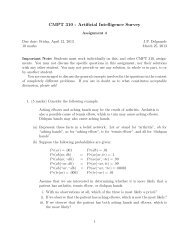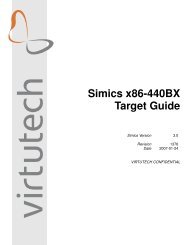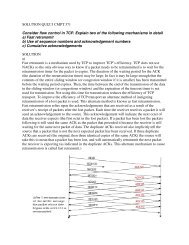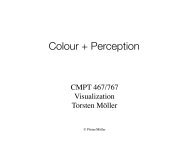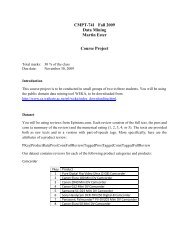Homework #2: CMPT-413
Homework #2: CMPT-413
Homework #2: CMPT-413
Create successful ePaper yourself
Turn your PDF publications into a flip-book with our unique Google optimized e-Paper software.
(7) †† Sino-Korean Number Pronunciation<br />
The Korean language has two different number systems. The native Korean numbering system is used for<br />
counting people, things, etc. while the Sino-Korean numbering system is used for prices, phone numbers,<br />
dates, etc. (called Sino-Korean because it was borrowed from the Chinese language).<br />
Write a program that takes a number as input and produces the Sino-Korean number pronunciation<br />
appropriate for prices using the table provided below. The program should accept any number from 1 to<br />
999, 999, 999 and produce a single output pronunciation. The commas are used here to make the numbers<br />
easier to read, and can be simply deleted from the input.<br />
You should produce the Korean romanized output (Korean written using the Latin script) as shown in the<br />
table, rather than the Hangul script (the official script for the Korean language).<br />
1 il 10 sib 19 sib gu 100 baek<br />
2 i 11 sib il 20 i sib 1,000 cheon<br />
3 sam 12 sib i 30 sam sib 10,000 man<br />
4 sa 13 sib sam 40 sa sib 100,000 sib man<br />
5 o 14 sib sa 50 o sib 1,000,000 baek man<br />
6 yuk 15 sib o 60 yuk sib 10,000,000 cheon man<br />
7 chil 16 sib yuk 70 chil sib 100,000,000 eok<br />
8 pal 17 sib chil 80 pal sib<br />
9 gu 18 sib pal 90 gu sib<br />
For example, the input 915, <strong>413</strong> should produce the output gu sib il man o cheon sa baek sib sam. Note<br />
that as shown the table above 1000 is pronounced cheon rather than il cheon, and so 111, 000 is<br />
pronounced as sib il man cheon. The testcases directory contains sample inputs and outputs.<br />
An intermediate representation makes this task much easier. For input 915, <strong>413</strong> consider the intermediate<br />
representation of 9[10]1[10ˆ4]5[10ˆ3]4[10ˆ2][10]3#, where [10], [10ˆ4] are symbols in an<br />
extended alphabet. The mapping from numbers to intermediate representation and the mapping into<br />
Korean pronunciations are both easily implemented as finite-state transducers. The intermediate forms for<br />
an FST implementation are provided in the ∗.hint files for each input.<br />
You can use the FST code from Q. 3 and Q. 4 or the more scalable OpenFST toolkit (installed in<br />
∼anoop/cmpt<strong>413</strong>/sw/).<br />
(8) †† Machine (Back) Transliteration<br />
Languages have different sound inventories. Full machine translation is a complex task, but a special case<br />
occurs when one wants to translate names, technical terms and even some recently introduced common<br />
nouns. Transliteration is the replacement of a loan word from a source language for names, technical<br />
terms, etc. with the approximate phonetic equivalents taken from the sound inventory of the target<br />
language. These phonetic equivalents are then written in the script of the language.<br />
For example, the noun phrase “New York Times” in English which would sound like “niyu yoku taimuzu”<br />
in Japanese using the sound system native to the Japanese language, which is then written down using the<br />
Katakana syllabic script typically used for loan words as: .<br />
Table 1 provides the mapping from Katakana to pronunciations. Use the file katakana-jpron.map for<br />
your implementation in order to convert the Japanese Katakana input in UTF-8 into Japanese<br />
pronunciation symbols in ASCII. Dealing with UTF-8 can be tricky. The file katakana jpron stub.py<br />
contains example Python code for dealing with UTF-8 input.<br />
Your task is to back transliterate from Japanese into English. It is called back transliteration since the<br />
original word was borrowed from English into Japanese.<br />
The following resources can be used to solve this task:<br />
1. The file katakana-jpron.map maps Katakana input to Japanese pronunciation symbols.<br />
4




